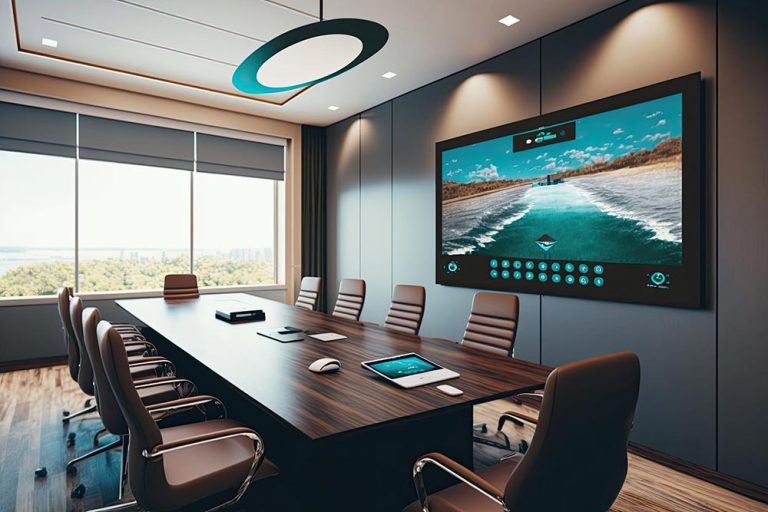
Technology has become the backbone of productivity, collaboration, and innovation. Work space (in office or remote) audiovisual (AV) systems play a vital role in facilitating communication, whether it’s for team meetings, client presentations, or virtual collaboration. However, if the systems do not function seamlessly it hampers their effectiveness. A user-friendly interface ensures that AV technology empowers employees rather than hinders them.
What Are User-Friendly Interfaces in AV Systems?
A user-friendly interface is designed to make technology accessible, simple, and intuitive for everyone, regardless of their technical proficiency. It emphasises:
- Simplicity: Interfaces should be clean and uncluttered, presenting only the necessary options.
- Intuitiveness: Users should instinctively know how to interact with the system without prior experience.
- Consistency: Uniform layouts and predictable features across different devices help users feel comfortable.
- Responsiveness: Quick feedback to user inputs ensures smooth operation.
- Accessibility: Interfaces must cater to users with varying abilities, making them inclusive for all.
Why User-Friendly Interfaces Matter in Office AV Systems
The design of an interface can make or break its adoption and functionality in the workplace. A user-friendly AV system can deliver numerous benefits:
- Boosts Productivity
Complex AV systems with confusing interfaces can waste valuable time during meetings. Employees may struggle to set up equipment or troubleshoot issues, delaying the start of discussions. Intuitive interfaces eliminate such frustrations, allowing teams to focus on their work rather than the technology.
- Reduces Training Costs
Systems with straightforward interfaces minimise the need for extensive training. New employees can quickly familiarise themselves with the tools, while existing staff can adapt to upgrades with ease. This reduces downtime and the costs associated with training programs.
- Increases Technology Adoption
Employees are more likely to embrace technology that is easy to use. High adoption rates mean that businesses can fully leverage their AV system investments.
- Minimises User Errors
Clear, logical designs reduce the chances of errors during operation. This leads to fewer disruptions, smoother meetings, and a more professional experience for all participants.
How User-Friendly Interfaces Enhance Collaboration
In a modern office, collaboration is key. User-friendly AV systems facilitate seamless interactions between team members, whether they are in the same room or across the globe.
- Simplifies Hybrid Meetings
With remote work becoming the norm, hybrid meetings are common. A well-designed interface ensures that in-person and remote participants can easily connect, share screens, and communicate effectively without technical glitches.
- Streamlines Presentations
Presenters should not have to fumble with cables or settings to share their content. A user-friendly AV system simplifies the process, allowing presentations to proceed smoothly and keeping the audience engaged.
- Supports Cross-Platform Compatibility
Modern AV interfaces should be compatible with various devices, including laptops, tablets, and smartphones. This flexibility ensures that employees can use their preferred tools without compatibility issues.
Designing User-Friendly AV Interfaces
Creating an interface that meets the needs of a diverse workforce requires careful planning and execution.
- Focus on the User Experience
The end-user should be at the center of interface design. Understanding their needs, preferences, and pain points is crucial to creating a system they’ll enjoy using.
- Incorporate Automation
Automating routine tasks, such as system start-up or input selection, can make AV systems more efficient. For example, a system that automatically detects connected devices and adjusts settings accordingly reduces manual effort.
- Provide Consistent Navigation
A consistent layout across all system screens ensures that users always know where to find controls, regardless of their specific task. This predictability fosters confidence and reduces confusion.
- Offer Real-Time Feedback
When users interact with the system, immediate feedback is essential. Whether it’s a progress bar or a simple acknowledgment of an input, feedback reassures users that the system is functioning as intended.
Benefits of User-Friendly Interfaces
The advantages of investing in user-friendly interfaces extend beyond convenience. These benefits have tangible impacts on business operations:
- Improved Collaboration
When technology works seamlessly, teams can communicate and collaborate without interruptions. This leads to faster decision-making and better project outcomes.
- Cost Savings
Reducing training time, minimising errors, and improving efficiency can significantly lower operational costs over time.
- Future-Proofing Investments
Technology evolves rapidly. Systems with user-friendly designs are more adaptable to upgrades and new features, ensuring a longer lifespan for your investment.
Adapting Interfaces for Diverse User Groups
- Addressing Varied Technical Skills
Workplaces often include a mix of tech-savvy employees and those less familiar with digital tools. Designing for inclusivity ensures that everyone can use the AV systems effectively.
- Catering to a Multi-Generational Workforce
Different generations have different experiences with technology. Interfaces that account for these variations can bridge the gap, providing a cohesive user experience for all employees.
- Supporting Remote Workforces
As remote work continues to grow, interfaces must be optimised for use on mobile devices and across virtual platforms. This ensures consistent functionality for users, no matter where they are.
The Future of AV Interfaces
As technology advances, the need for user-friendly designs will only increase. Innovations like voice-activated controls, AI-driven personalisation, and augmented reality integrations are set to transform how we interact with AV systems. However, the core principle remains the same: technology should empower users, not intimidate them.
Organisations that prioritise user-friendly interfaces will reap the rewards of increased efficiency, higher employee satisfaction, and a competitive edge in their industries.
Conclusion
User-friendly interfaces are not just a luxury; they are a necessity in today’s tech-driven workplaces. By simplifying complex AV systems, organisations can unlock their full potential, driving productivity, collaboration, and innovation. As the demand for seamless technology continues to grow, investing in intuitive AV interfaces will remain a cornerstone of successful business operations.